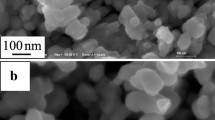Abstract
The current-voltage characteristics of thin-film capacitors with evaporated terbium fluoride dielectric have been studied as a function of temperature (in the range 300 to 418 K). For sufficiently high electric fields (> 104 V cm−1, the leakage current is found to increase exponentially with the square root of the applied electric field. Analysis of the data suggests an electrode-limited mechanism such as that suggested by Schottky. It is seen that the conduction mechanism is an activated process with the activation energy decreasing with increasing field. Dielectric break-down and its dependence on film thickness have also been investigated. Break-down field strength follows the Forlani-Minnaja relation.
Similar content being viewed by others
References
D. L. Pulfrey, A. H. M. Shousha andL. Young,J. Appl. Phys. 41 (1970) 2838.
L. Sullivan andH. C. Card,J. Phys. D 7 (1974) 1531.
A. M. Phahle,Thin Solid Films 46 (1977) 315.
N. Klein,ibid. 7 (1971) 149.
V. K. Agarwal andV. K. Srivastava,ibid. 8 (1971) 377.
A. T. Fromhold, Jr,Phys. Stat. Solidi 36 (1969) K129.
M. Sayer, M. Suzanne Martin andN. J. Hellicar,Thin Solid Films 6 (1970) R61.
E. Riemann andL. Young,J. Appl Phys. 44 (1973) 1044.
T. Yabumoto, H. Matsumoto andS. Marui,Japan. J. Appl. Phys. 11 (1972) 1858.
K. R. Paramasivam, M. Radhakrishnan andC. Balasubramanian,Thin Solid Films 14 (1980) 189.
A. K. Jonscher,ibid. 1 (1967) 213.
A. E. Hill, A. M. Phahle andJ. H. Calderwood,ibid. 5 (1970) 287.
A. Servini andA. K. Jonscher,ibid. 3 (1969) 341.
V. K. Agarwal andH. Mitsuhashi,ibid. 41 (1977) 271.
P. J. Reucroft andS. K. Ghosh,ibid. 20 (1974) 363.
D. M. Hughes andM. W. Jones,J. Phys. D 7 (1974) 2081.
M. J. Rand andJ. F. Roberts,J. Electrochem. Soc. 115 (1968) 423.
H. Hirose andY. Wada,Japan J. Apply. Phys. 4 (1965) 639.
F. Forlani andN. Minnaja,Phys. Stat. Solidi 4 (1964) 311.
Idem, J. Vac. Sci. Technol. 6 (1969) 518.
P. P. Budenstein, P. J. Hayes, J. L. Smith andW. B. Smith,ibid. 6 (1969) 289.
A. Goswami andA. P. Goswami,Thin Solid Films 16 (1973) 175.
V. K. Agarwal andV. K. Srivastava,ibid. 13 (1972) S23.
Author information
Authors and Affiliations
Rights and permissions
About this article
Cite this article
Paramasivam, K.R., Radhakrishnan, M. & Balasubramanian, C. Electrical conduction in evaporated terbium fluoride thin films. J Mater Sci 16, 1183–1186 (1981). https://doi.org/10.1007/BF01033829
Received:
Accepted:
Issue Date:
DOI: https://doi.org/10.1007/BF01033829




